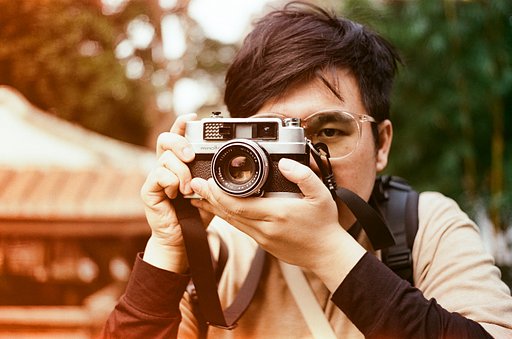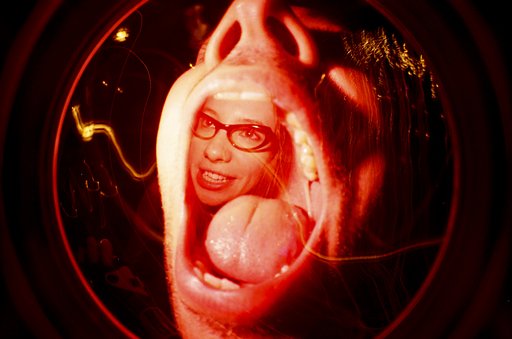How Not to Live on Autopilot: Adali Schell's Street Photography with the Lomography Color Negative
10 Share TweetAs a so-called digital native, Los Angeles-based photographer Adali Schell first discovered his interest in taking pictures and only later explored the medium in more depth which led him to shoot film only. Especially out in the streets, hunting down fleeting, unique moments, split seconds that determine whether or not your photo is going to be everything or nothing, it takes courage choosing to embark on this adventure the analog way. Adali appreciates exactly that – the necessity to be fully aware and completely in the moment.
Hi Adali, welcome to the Lomography Magazine! Please introduce yourself to our readers in your own words.
Hey! I'm Adali Schell, my pronouns are he/him, I was born and raised in Los Angeles.
When and how did you discover film photography as a passion of yours?
I initially discovered photography around the age of 11, but the film awakening came later at 17. My dad unearthed his old Nikon Nikkormat with a 24 mm lens, (the same set up that he used to photograph my birth.) Toying with the back open, watching how the aperture shrinks and expands and what different shutter speeds look like through the curtain really hooked me and allowed me to understand what a camera actually is. Then I took a 3-week darkroom course at the School of Visual Arts in NYC with Ellen Wallenstein, and there I developed my own film and made my first prints. Afterward, I switched to color, and I've been shooting every day since.
Especially for street photography, shooting on film can make it much harder than digital. Why do you choose this challenge?
I don't necessarily see it as a harder or easier question, I just prefer film because I think it looks better. I've also always been overwhelmed by digital cameras - I still don't really understand sensors and megapixels, and I've never been interested in spending a few thousand dollars for an up to standard digital camera just to need to buy a new one a few years later. 35mm has always been a standard, and I've taken comfort in this.
What's your go-to gear when you hit the streets?
My Leica M4-P, Lomography Color Negative film, flash, some water, a hat, sunscreen, comfortable shoes.
What is it about street photography that fascinates you?
To me, this practice is less about taking pictures on the street and more about attention, awareness, sensitivity, and appreciation for life that otherwise would go unrecorded. It's too easy to succumb to life's pressures and be forced into autopilot mode. I'm trying to live all of my life consciously - present and feeling everything, testing both the limits of photography and even the most insignificant and fleeting relationships with people and inanimate objects. Before I was shooting with much intention, I spent two years in my room saying no to life, and once I understood the camera I decided to try to let no moment pass through me without a conscious decision to think about what is happening around me. Consequently, I've made the pictures I have, and there's been around 100 years of these beautiful, fleeting moments that fall under the term street photography; moments we've been lucky enough to commemorate and celebrate. Street photography is for everyone.

Can you pick one shot from this series and tell us the story behind it?
The trampoline picture [above] was a big one for me - I took this just a few weeks ago in Santa Rosa, California. Kids were jumping around, and I was shooting them through the protective netting, I had no idea what kinds of pictures I was making. This picture feels like something by Mark Cohen, who is one of my all-time favorite photographers. I feel like there is a quality to some pictures that excel beyond the form and subject of the photo, and create a kind of dream-like, surreal vibration. My practice is normally very photojournalistic and realistic, and taking a stab at something less feels magical to me.
Who are some photographers you admire?
There are so many. I’d have to first state my unparalleled admiration for Winogrand and his photographic philosophies. His relentless personal photographic investigations have birthed this mostly candid human niche that has expanded itself on Instagram - without him, I’d dare to say that none of this would really exist (that is, of course by also acknowledging Robert Frank and Walker Evans, who I feel less drawn to possibly because of how old their work is, alongside Vivian Maier and Helen Levitt who are the first two street photographers I’d ever discovered.) Of course, there’s Lee Friedlander, Joel Meyerowitz, Richard Sandler, Paul McDonough, Mark Steinmetz, and Henry Wessel whose work I think directly addresses and builds upon Winogrand’s ideas, and that’s just for black and white. Artists like John Harding, Joel Meyerowitz, Jeff Mermelstein, Todd Gross, and Daniel Arnold I feel push these defined boundaries into the realm of color, yet this is still very New York-centric, so applying this to Los Angeles’ domain is what I find to be the most inspiring and relative to my life. With that said, Anthony Hernandez can’t go unstated, whose photographic career overlaps a history of Los Angeles. Lauren Greenfield has some amazing LA color work, in my book she's a genius, and so is David Strick in a more Hollywood, humorous manner. Photojournalists like Garry Leonard, Douglas McCulloh, and Marissa Roth are amazing and blend together a sensitive awareness of Los Angeles and it’s people while pursuing narrative photojournalism. Alex Prager is a huge name for me, as she’s formed this Hollywoodesque, theatrical, street-feeling yet staged commercial photography that has shown just how far the photographic envelope can be pushed. John Humble’s LA landscapes are everything to me, and the inspiration I gain from his structural compositions are akin to works by Andrew Boroweic, Stephen Shore, Joel Sternfeld, Justine Kurland, Alec Soth and Catherine Opie’s landscape work.
There are also newer names who I admire every day through Instagram such as Austin Leong, Sean Colello, Kyle Myles, Joey Prince, Geoff Haggray, Jonathan Walker, Sebastian Siadecki, Joe Plonsker, Jon Laytner, Jamie Lee Curtis Taete, Dane Manary, Lev Rukhin, Andy Walker, Youngjae Lim, Jorge Garcia, Trevor Wisecap, Chris Saccente, Chris Voss, Sara Messinger, Blake Andrews, Daniel Gutierrez, Sinna Nasseri, Jerry Hsu, Eric Andrade, Kyle Berger, Camilo Fuentealba, Jake Ricker, Troy Holden, Brian Karlsson, Chris Ostinato, Luis Garcia, Ben Kru, Andres Rios, Adam Powell, Julian Master, Frank Multari, Mathias Wasik, Chris Verene, Chris Maggio, and of course, Daniel Arnold.
What's your goal for your photography?
I'm just hoping to never go on autopilot mode. Photography is the vessel for my consciousness, so as long as I have a camera in hand I am always reminded that I am alive.
Follow Adali's adventures on the streets via his Instagram.
written by birgitbuchart on 2021-08-05 in #gear #people #street-photography #color-negative-400 #color-negative-100



























未有留言